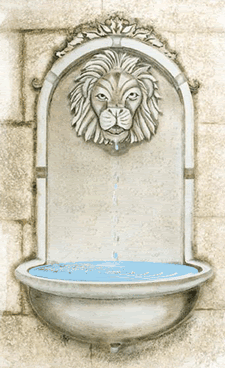Bism II
Wait! Before you read more about Bism, be sure to read the trip report that Roger has posted about his tour of Oxford and C.S. Lewis's home.
Now for more of the chapter "The Bottom of the World", from The Silver Chair:
“Your Honors,” said Golg (and when they turned to look at him they could see nothing but blackness for a few minutes, their eyes were so dazzled). “Your Honors, why don’t you come down to Bism? You’d be happier there than in that cold, unprotected, naked country out on top. Or at least come down for a short visit.”
Jill took it for granted that none of the others would listen to such an idea for a moment.
To her horror she hear the Prince saying:
“Truly, friend Golg, I have half a mind to come down with you. For this is a marvelous adventure, and it may be no mortal man has ever looked into Bism before or will ever have the chance again. And I know not how, as the years pass, I shall bear to remember that it was once in my power to have probed the uttermost pit of the Earth and that I forbore. But could a man live there? You do not swim in the fire-river itself?”
“Oh no, you Honor. Not we. It’s only salamanders live in the fire itself.”
“What kind of beast is your salamander?” asked the Prince.
 “It is hard to tell their kind, your Honor,” said Golg. “For they are too white-hot to look at. But they are most like small dragons. They speak to us out of the fire. They are wonderfully clever with their tongues: very witty and eloquent.”…
“It is hard to tell their kind, your Honor,” said Golg. “For they are too white-hot to look at. But they are most like small dragons. They speak to us out of the fire. They are wonderfully clever with their tongues: very witty and eloquent.”… “Quick! Quick! Quick! To the cliffs, to the cliffs, to the cliffs!” it said. “The rift closes. It closes. It closes.”
See more wonderful Narnia illustrations by the artist Edwina Peterson Cross here.




1 Comment(s):
I found this little tidbit on www.livingunderworld.org, a site on amphibian folklore (gotta love the internet):
"Salamanders have been linked to fire as far back as the times of Aristotle (384-322 BCE.); the word salamander is of Greek origin, and translates roughly to "Fire-Lizard". It was believed that salamanders were immune to fire, and could extinguish fire with skin secretions. In 1607, Edward Topsel published the book The History of Four-Footed Beasts and Serpents, which, along with illustrations of newts and salamanders resembling serpents and dragons, hypothesizes about the ability of salamanders to extinguish fire, receive nourishment from fire, and traverse through fire unscathed."
Post a Comment
<< Home